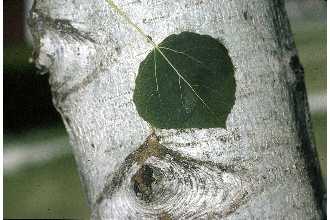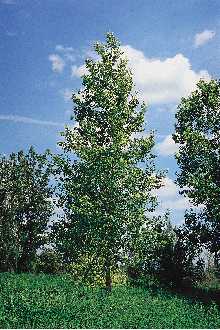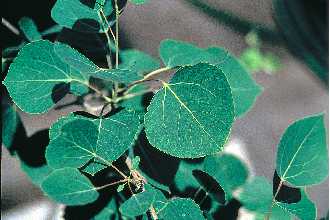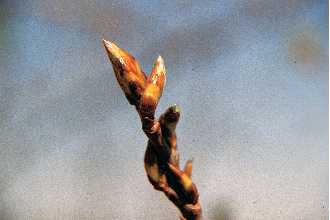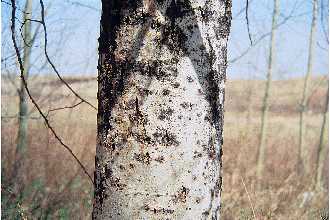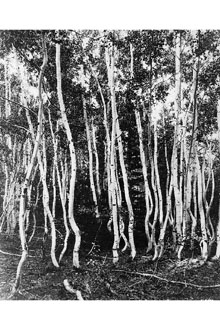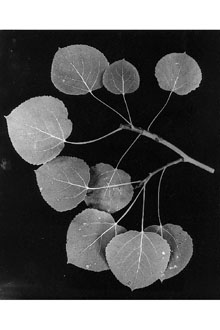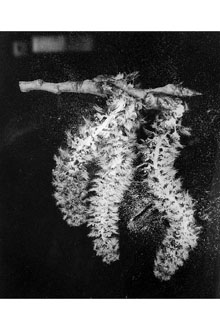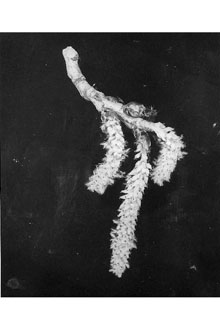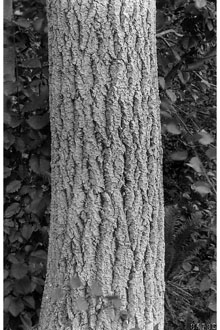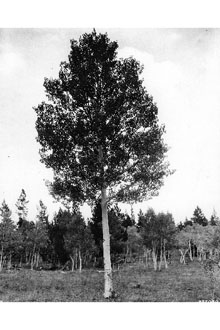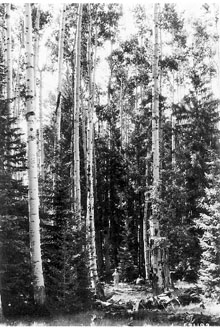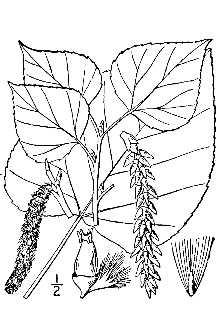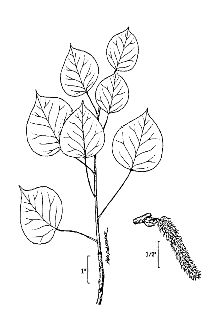Populus tremuloides Michx. var. rhomboidea Vict.
Scientific Name: Populus tremuloides Michx. var. rhomboidea Vict.
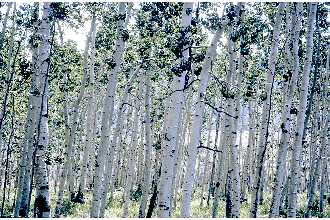
| General Information | |
|---|---|
| Usda Symbol | POTRR |
| Group | Dicot |
| Life Cycle | Perennial |
| Growth Habits | Tree |
| Native Locations | POTRR |
Plant Guide
Alternate Names
Trembling aspen, golden aspen, mountain aspen, trembling poplar, white poplar, popple; aspen
Uses
Industry: Quaking aspen is an important fiber source, especially for pulp, flake-board, and other composite products. The wood is light and soft with little shrinkage (see Wheeler 2000) and is used for pallets, boxes, veneer, and plywood. Higher grades are used for other solid wood products, such as paneling, furniture components, and flooring. The wood characteristics make it useful in miscellaneous products, including excelsior, animal bedding, matchsticks, toys, beehives, tongue depressors, spoons, and ice cream sticks. It makes good playground structures because the surface does not splinter, although the wood warps and susceptible to decay. Conservation: Quaking aspen is valued for its white bark and brilliant fall color, especially when clustered. The species been widely used in landscaping but is best in sites away from structures that might be damaged by the aggressive roots. The trees provide good visual screening and noise abatement. Brother Alfred Brousseau © St Mary’s College @ CalPhotos Aspen stands are good firebreaks, often dropping crown fires in conifer stands to the ground when they reach aspens and even sometimes extinguishing the fire because of the small amount of flammable accumulation. They allow more ground water recharge than do conifer forests and they also play a significant role in protecting against soil erosion. They have been used in restoration of riparian habitats. Wildlife: Young quaking aspen provides food and habitat for a variety of wildlife: black bear, deer, beaver, porcupine, elk, moose, ruffed grouse and many smaller birds and animals, including small mammals such as mice, voles, shrews, chipmunks, and rabbits. Bark, buds, new sprouts, twigs from the tops of fallen or logged trees, and fallen leaves all are wildlife foods. Ethnobotanic: Native Americans used Populus bark (including aspen) as a food source. They cut the inner bark into strips, dried and ground it into meal to be mixed with other starches for bread or mush. Catkins were eaten raw, and the cambium was eaten raw or in a soup.
Status
Please consult the PLANTS Web site and your State Department of Natural Resources for this plant’s current status, such as, state noxious status and wetland indicator values.
Description
General: Willow Family (Salicaceae): This is a native tree 5-30 m high, typically less than 15 m, with a rounded crown; lateral roots may extend over 30 meters and vertical sinker roots from the laterals may extend downward for nearly 3 m; bark typically smooth, greenish-white to gray-white, often thin and peeling, becoming thicker and furrowed with age, especially toward the base. Leaves simple, deciduous, broadly ovate to nearly round, 4–6 cm long, with small, rounded teeth on the margins, on a slender, flattened petiole, dark green and shiny above, pale green below, turning bright yellow, yellow-orange, gold, or reddish after the first frosts. The male (staminate) and female (pistillate) flowers are on separate trees (the species dioecious – or ‘polygamodioecious,’ because bisexual flowers may be produced at low frequencies on staminate and pistillate trees), each type of flower borne in pendent catkins. The fruits are narrowly ovoid to flask-shaped capsules 5-7 mm long, splitting to release the seeds; seeds ca.2 mm long, each with a tuft of long, white, silky hairs, easily blown by the wind. The common name is in reference to the shaking of the leaves in light wind. Variation within the species: Considerable genetic and morphological variation exists over the range of quaking aspen. A number of species and varieties have been described but none are currently recognized. Entire stands are often produced as a single clone from root sprouts – this sometimes easily observable on a single mountainside in different timing in leaf appearance or in different hues and timing of fall coloration. Distinctively large triploid trees are sometimes found. Quaking aspen hybridizes naturally with bigtooth aspen (Populus grandidentata), narrowleaf cottonwood (P. angustifolia), curly poplar (P. canescens), balsam poplar (P. balsamifera), eastern cottonwood (P. deltoides), and white poplar (Populus alba, a naturalized European species), and hybrids with black cottonwood (P. trichocarpa) occur rarely in Alaska. Quaking aspen, bigtooth aspen, European aspen (P. tremula), and three Asian species are closely related and sometimes classed together as a single, circumglobal superspecies (see Peterson and Peterson 1992).
Distribution
Quaking aspen is the most widely distributed tree species in North America. It grows from Alaska across the Northwest Territories to Quebec and Newfoundland, south to West Virginia and Virginia, and in all of the western North America US states (except Oklahoma and Kansas) -- in all Canadian provinces and all but 13 US states (absent from the Southeast). It occurs in both the eastern and western sierras of Mexico, into the south-central part of the country. Outside of the main range, it is represented by a huge number of disjunct populations. For current distribution, please consult the Plant Profile page for this species on the PLANTS Web site.
Adaptation
Quaking aspen occurs in a wide variety of habitats (including soil type and moisture conditions) and at a great range of elevation, matching its extensive geographic range. It characteristically forms pure stands or mixed stands with bigtooth aspen, but it occurs with scrub oaks and sagebrush at lower elevations and as a prostrate form above timberline and exists as a dominant species in many communities at mid elevations. It is a shade-intolerant, disturbed site species and is quickly replaced in succession by more tolerant species. Some trees are self-pruning, dropping numerous small twigs with excess fall foliage and returning nutrients to the soil. Leaves decay relatively rapidly, and a characteristic "aspen soil," with a higher pH than on conifer-dominated soils, develops on sites that have supported aspen for a number of generations. Flowering occurs March–April (East) or May–June (West), before the leaves appear and fruiting in May–June (–July), often before the leaves are fully expanded. Temperatures above 12° C for about 6 days apparently trigger flowering. Female trees generally flower and leaf out before male trees.
Establishment
Quaking aspen commonly establishes from seed in Alaska, northern Canada, and eastern North America. Seedling establishment is less common in the West but occurs there in moist sites such as kettles and other topographic depressions, seeps, springs, lake margins, and burnt-out riparian zones. Drought stress kills seedlings, as does standing water. Young trees first flower at 2-3 years but production of large seed crops begins at about 10-20 years; maximum seed production occurs at 50-70 years. Heavy seed crops are produced at 4-5-year intervals. Seeds are wind-dispersed for distances of 500 meters to several kilometers. Germination generally begins nearly immediately after moisture is received and can occur across a broad temperature range, with optimal germination at 15-25° C. Surface placement or a very shallow depth of burial on exposed mineral soil (such as burned or scarified sites) apparently provide the best environment for germination. Continuous moisture is required. Asexual reproduction and clones Reproduction of quaking aspen is primarily by root sprouts, and extensive clones of root-interconnected trees are characteristic of the species. Most root sprouts develop within 10 meters of the parent stem, although some are produced at 30 meters or more. They develop from roots within 2-10 centimeters of the surface. Growth in primordia and buds is suppressed by apical dominance but resumes after stems are top-killed by fire, harvest or wind-breakage, or after defoliation and many thousands of sprouts per acre may be produced. Removal of the above-ground plant portion in June or July after maximum auxin production (the chemical agent of apical dominance) results in fewer suckers than top-removal during the dormant season. Sprouts produced in a closed stand usually die unless in a canopy gap. Saplings may begin producing root sprouts at 1 year of age. Stands of quaking aspen may consist of a single clone or represent a mosaic of different clones. Even in a small area, wide variation in genetic traits exists between clones – differences may be seen in leaf shape and size, bark colour and texture, branching habit, resistance to disease and insect attack, sexual expression, growth rate, and phenology. The most conspicuous differences may be in the timing of spring leaf flush and in autumn leaf coloration. The staminate-pistillate ratio of clones is 1:1 in most localities, but in the eastern US staminate trees may outnumber pistillate ones by 3:1. Some clones alternate between staminate and pistillate forms in different years or produce combinations of perfect, staminate, and pistillate flowers. Individual trees of quaking aspen are short-lived (maximum age in the Great Lakes states is 50–60 years, up to 150 years in the West). Stands may be even-aged (after a single top-kill event) or only broadly even-aged (from sprouting of a gradually deteriorating stand). The clones are much older: many in the Rocky Mountain and Great Basin regions are at least 8000 years old, persisting since the last glacial retreat. A male clone in the Wasatch Mountains of Utah occupies 17.2 acres (43 ha) and has more than 47,000 stems – this clone is estimated to be 1 million years old and may be the world's most massive known organism. Clones east of the Rocky Mountains usually cover no more than a few acres.
Management
The thin, soft bark of quaking aspen makes it susceptible to many diseases and insect infestations as well as mechanical and fire damage, Fires may kill trees or cause basal scars that serve as entry points for wood-rotting fungi, which are common in older stands, Use soil moisture sensors to measure the soil moisture of Populus tremuloides Michx. var. rhomboidea Vict.., The wood decays easily, Fires may also kill surface roots that could reduce sucker regeneration, The poplar borer beetle, one of the most common wood borers of aspen, weakens trees by boring galleries in the trunk near the lower portion of the crown, Outbreaks of forest tent caterpillar may last 4-5 years and result in serious defoliation -- cold weather in the spring shortly after the eggs hatch and above-average fall temperatures can cause a rapid decline in caterpillar populations by killing eggs and larvae, Overgrazing by livestock or big-game animals disturbs roots and compacts soil, limiting sucker formation, Heavy grazing of young sucker stands by cattle for three years in a row may destroy them, Quaking aspen can be propagated by seed, following cold stratification, Germination of fresh seed may be 80-95%, but viability lasts only 2-4 weeks under favorable natural conditions (low temperature and humidity), Seeds dried for 3 days and stored at cool temperatures may retain good viability for up to a year, The species roots poorly from woody stem cuttings, but newly initiated (softwood) shoots can usually be induced to root by dipping in IBA (indolebutyric acid) or other commercially available rooting powders, A more preferred method uses root sprouts, Collect dormant lateral roots in early spring -- plant root cuttings 1-2 in diameter and 3-5 centimeters long in vermiculite and place in the greenhouse for 6 weeks, Excise the young sucker shoots and root in perlite/vermiculite (2-3 weeks, using IBA), misting frequently, Transplant the developing plants to peat/vermiculite mix and grow at 15-25º C, Or, the root cuttings may be planted directly into the perlite mix, with the top of the cutting just below the media surface, Cultivars, Improved and Selected Materials (and area of origin) Contact your local Natural Resources
Conservation
Service (formerly Soil Conservation Service) office for more information. Look in the phone book under ”United States Government.” The Natural Resources Conservation Service will be listed under the subheading “Department of Agriculture.”
References
Bozie, T. 1999. The aspen tree (Populus tremuloides). In your woodlot, Vol. 8, Issue #3. Farm Woodlot Assoc. of Saskatchewan. SEP00. <http://www.aginfonet.com/agricarta/content/farm_woodlot_assoc_of_sask/aspen.html> Perala, D. A. 1990. Populus tremuloides. Michx. Quaking aspen. Pp. 555-569, IN: R.M. Burns and B.H. Honkala. Silvics of North America. Volume 2. Hardwoods. USDA Forest Service Agric. Handbook 654, Washington, D.C. <http://willow.ncfes.umn.edu/silvics_manual/Volume_2/populus/tremuloides.htm> Accessed September 2000. Peterson, E. B. & N. M. Peterson 1992. Ecology, management, and use of aspen and balsam poplar in the Prairie Provinces, Canada. Special Report 1. Forestry Canada, Northwest Region, Northern Forestry Centre, Edmonton, Alberta, Canada. Prasad, A. M. & L. R. Iverson 1999. A climate change atlas for 80 forest tree species of the eastern United States. USDA, Forest Service, Northeastern Research Station, Delaware, Ohio. SEP00. <http://www.fs.fed.us/ne/delaware/atlas/> The Australian Naturopathic Network 2000. Populus tremuloides. SEP00. <http://www.ann.com.au/herbs/Monographs/populus. htm> Tirmenstein, D. 1988 (rev. J.L. Howard 1996). Populus tremuloides. IN: D. G. Simmerman (compiler). The fire effects information system [Data base]. USDA, Forest Service, Intermountain Research Station, Intermountain Fire Sciences Laboratory, Missoula, Montana. AUG00. <http://www.fs.fed.us/database/feis/plants/tree/poptre/> Wheeler, E. E. 2000. Forest Products – Commercial Species. Dept. of Community and Economic Development. Alaska Division of Trade and Development. AUG00. <http://www.dced.state.ak.us/econdev/tree5.htm>
Plant Traits
Growth Requirements
| Temperature, Minimum (°F) | -70 |
|---|---|
| Adapted to Coarse Textured Soils | Yes |
| Adapted to Fine Textured Soils | Yes |
| Adapted to Medium Textured Soils | Yes |
| Anaerobic Tolerance | Low |
| CaCO3 Tolerance | High |
| Cold Stratification Required | No |
| Drought Tolerance | Low |
| Fertility Requirement | Medium |
| Fire Tolerance | High |
| Frost Free Days, Minimum | 70 |
| Hedge Tolerance | Low |
| Moisture Use | High |
| pH, Maximum | 9.0 |
| pH, Minimum | 4.3 |
| Planting Density per Acre, Maxim | 1200 |
| Planting Density per Acre, Minim | 300 |
| Precipitation, Maximum | 60 |
| Precipitation, Minimum | 7 |
| Root Depth, Minimum (inches) | 32 |
| Salinity Tolerance | Medium |
| Shade Tolerance | Intolerant |
Morphology/Physiology
| Bloat | None |
|---|---|
| Toxicity | None |
| Resprout Ability | Yes |
| Shape and Orientation | Rounded |
| Active Growth Period | Spring and Summer |
| C:N Ratio | Medium |
| Coppice Potential | Yes |
| Fall Conspicuous | No |
| Fire Resistant | Yes |
| Flower Color | Blue |
| Flower Conspicuous | No |
| Foliage Color | Green |
| Foliage Porosity Summer | Dense |
| Foliage Porosity Winter | Porous |
| Foliage Texture | Medium |
| Fruit/Seed Conspicuous | No |
| Nitrogen Fixation | None |
| Low Growing Grass | No |
| Lifespan | Short |
| Leaf Retention | No |
| Known Allelopath | No |
| Height, Mature (feet) | 65.0 |
| Height at 20 Years, Maximum (fee | 40 |
| Growth Rate | Rapid |
| Growth Form | Single Stem |
| Fruit/Seed Color | White |
Reproduction
| Vegetative Spread Rate | Moderate |
|---|---|
| Small Grain | No |
| Seedling Vigor | Low |
| Seed Spread Rate | Moderate |
| Seed per Pound | 3248000 |
| Fruit/Seed Persistence | No |
| Propagated by Tubers | No |
| Propagated by Sprigs | No |
| Propagated by Sod | No |
| Propagated by Seed | Yes |
| Propagated by Corm | No |
| Propagated by Cuttings | Yes |
| Bloom Period | Mid Spring |
| Commercial Availability | Routinely Available |
| Fruit/Seed Abundance | High |
| Fruit/Seed Period Begin | Spring |
| Fruit/Seed Period End | Summer |
| Propagated by Bare Root | Yes |
| Propagated by Bulb | No |
| Propagated by Container | Yes |
Suitability/Use
| Veneer Product | Yes |
|---|---|
| Pulpwood Product | Yes |
| Protein Potential | Low |
| Post Product | No |
| Palatable Human | No |
| Palatable Graze Animal | Medium |
| Palatable Browse Animal | High |
| Nursery Stock Product | Yes |
| Naval Store Product | No |
| Lumber Product | Yes |
| Fuelwood Product | Low |
| Fodder Product | No |
| Christmas Tree Product | No |
| Berry/Nut/Seed Product | No |

